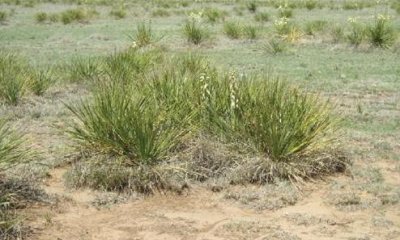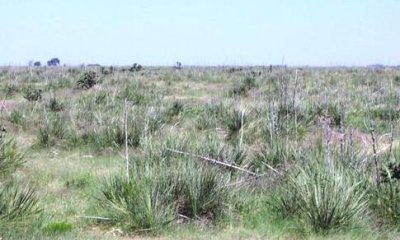
Limy Upland 16-21" PZ
Scenario model
Current ecosystem state
Select a state
Management practices/drivers
Select a transition or restoration pathway
-
Transition T1A
Absence of disturbance and natural regeneration over time, may be coupled with excessive grazing pressure
More details -
Restoration pathway R2A
Adequate rest from defoliation and removal of woody canopy, followed by reintroduction of historic disturbance regimes
More details -
Transition T2A
Absence of disturbance and natural regeneration over time, may be coupled with excessive grazing pressure
More details -
Restoration pathway R3A
Adequate rest from defoliation and removal of woody canopy
More details -
No transition or restoration pathway between the selected states has been described
Target ecosystem state
Select a state
State 1
Midgrass Grassland State



Description
The Midgrass/Shortgrass Community consists of mid and shortgrasses with few tallgrasses. Productivity is moderate with most of the production coming from sideoats grama and blue grama. Lesser amounts of buffalograss, hairy grama, sand dropseed, and perennial three-awn are found on the site. Vine mesquite and western wheatgrass are found growing in depressional areas. Small pockets of sand bluestem and Indiangrass may be found scattered throughout the site. Little bluestem will occur in small amounts where the soil becomes shallower. Some perennial forbs are present with small numbers of annual forbs and a few scattered woody shrubs. The primary woody species found are yucca and broom snakeweed, with an occasional catclaw mimosa and plains pricklypear; however, trees are seldom found on this site.
The tendency of this site is to become a shortgrass dominant site if long-term grazing abuse occurs. This will lead to a decline in the vigor of sideoats grama and other desirable mid and tallgrass species. Blue grama and buffalograss will increase because they are better able to withstand grazing pressure. Cholla, yucca and broom snakeweed will increase due to weakened grass cover and produces seed for several yearsThe decrease in density and stature of the mid and tallgrasses, an increase in shortgrasses, and an increase of yucca and other woody vegetation brings about a new plant community, the Midgrass/Shortgrass/Shrub Community (1.2).
Submodel
Description
If heavy grazing continues with no form of brush and pest management, a threshold will be crossed to a Shortgrass/Shrub State. Typical vegetation will be low vigor, blue grama with increasing amounts of low quality shortgrasses. Bare areas will increase with annuals filling the voids. Perennial three-awn will invade this site when the more desirable grasses are weakened and/or removed. Yucca, and occasionally broom snakeweed, will increase dramatically. Nutrient cycling, the water cycle, watershed protection and biological functions have been severely reduced.
Submodel
Description
When long-term, continuous heavy grazing occurs, this site will regress to the Shrub/ Shortgrass/Annuals Community (3.1). In this degraded state, yucca and broom snakeweed will dominate the site (>50 percent). Typical herbaceous vegetation will be perennial three-awn, low quality shortgrasses, and low vigor, sod bound blue grama. The large, connected bare areas will have numerous annual species present. The loss of herbaceous cover and increased bare ground encourages accelerated erosion.
Submodel
Mechanism
With heavy continuous grazing, no brush management, no fires (periods greater than twenty years between fires), brush invasion of yucca, pricklypear, and cholla, and no pest management, the Midgrass Grassland State will transition to the Shortgrass/Shrub Community.
Mechanism
With the application of various conservation practices for rangeland including Brush Management, Prescribed Grazing, Pest Management, Prescribed Burning over a two to three year period, the Shortgrass/Shrub State can be restored to the Midgrass Grassland State.
Relevant conservation practices
| Practice | External resources |
|---|---|
|
Brush Management |
|
|
Prescribed Burning |
|
|
Prescribed Grazing |
|
|
Integrated Pest Management (IPM) |
Mechanism
With heavy continuous grazing pressure by livestock and wildlife, no brush management, and no pest management, the Shortgrass Grassland State will transition to the Shrubland State.
Mechanism
Conservation practices required include prescribed grazing with several consecutive (3-4 years) rest periods during the growing season, re-seeding bare areas with adapted native grass species, and chemical brush and pest management. Prescribed burning is not an option in this phase.
Relevant conservation practices
| Practice | External resources |
|---|---|
|
Brush Management |
|
|
Prescribed Grazing |
|
|
Range Planting |
Model keys
Briefcase
Add ecological sites and Major Land Resource Areas to your briefcase by clicking on the briefcase (![]() ) icon wherever it occurs. Drag and drop items to reorder. Cookies are used to store briefcase items between browsing sessions. Because of this, the number of items that can be added to your briefcase is limited, and briefcase items added on one device and browser cannot be accessed from another device or browser. Users who do not wish to place cookies on their devices should not use the briefcase tool. Briefcase cookies serve no other purpose than described here and are deleted whenever browsing history is cleared.
) icon wherever it occurs. Drag and drop items to reorder. Cookies are used to store briefcase items between browsing sessions. Because of this, the number of items that can be added to your briefcase is limited, and briefcase items added on one device and browser cannot be accessed from another device or browser. Users who do not wish to place cookies on their devices should not use the briefcase tool. Briefcase cookies serve no other purpose than described here and are deleted whenever browsing history is cleared.
Ecological sites
Major Land Resource Areas
The Ecosystem Dynamics Interpretive Tool is an information system framework developed by the USDA-ARS Jornada Experimental Range, USDA Natural Resources Conservation Service, and New Mexico State University.




